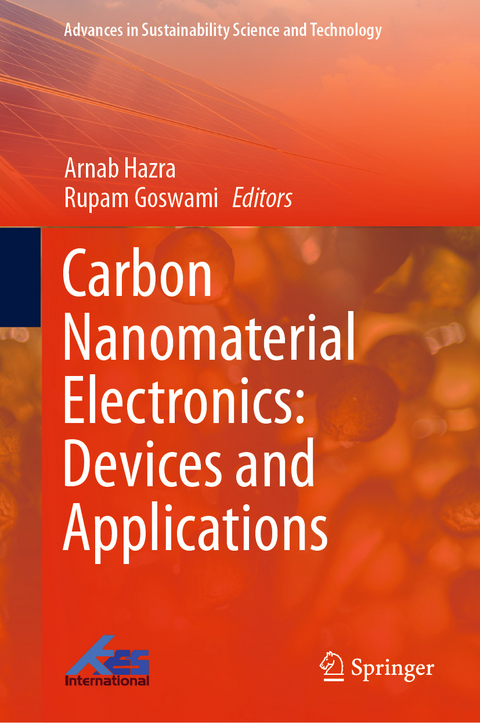
Carbon Nanomaterial Electronics: Devices and Applications
Springer Verlag, Singapore
978-981-16-1051-6 (ISBN)
Arnab Hazra received his M.Tech. and Ph.D. from Indian Institute of Engineering Science and Technology (IIEST), Shibpur, India, in 2011 and 2015, respectively. Presently, he is an Assistant Professor in the Department of Electrical and Electronics Engineering, Birla Institute of Technology and Science (BITS), Pilani, Rajasthan, India. He worked as a visiting scientist at Tel Aviv University, Israel and Sensor Laboratory, University of Brescia, Italy in 2018. His current research interest includes nanoscale materials based devices for gas sensing and memristive applications and 2D materials based field effect devices. He has published about seventy research articles in the journals and conferences of international repute, two book chapters and received two Indian patents. He received best Ph.D. thesis award by Indian National Academy of Engineering (INAE) and ISSS, India, in 2015 and 2016, respectively. He also received IEI young engineer award by the Institute of Engineers, India, in 2016. Rupam Goswami obtained his M.Tech. in 2014, and Ph.D. in 2018 from National Institute of Technology Silchar. India. Currently he is an Assistant Professor at the Department of Electronics and Communication Engineering, School of Engineering, Tezpur University, India. Before joining Tezpur University, he worked as an Assistant Professor at Birla Institute of Technology and Science Pilani, Rajasthan, India. His research interests include simulation and modeling of TFETs, HEMTs, FinFETs, and memristors. He has published his work in 2 books, 16 international peer-reviewed journals, and 13 international peer-reviewed conferences.
Chapter 1. Introduction.- Part 1: Synthesis and characterizations.- Chapter 2. Synthesis of carbon allotropes in nanoscale regime.- Chapter 3. Scanning tunneling microscopy (STM) imaging of carbon nanotropes: C60, CNT and Graphene.- Chapter 4. Carbon: A phantom for nanocomposite driven applications.- Chapter 5. Carbon-Based Nanocomposites: Processing, Electronic Properties And Applications.- Chapter 6. Tuning of SPR and Structural Properties of Cu-fullerene metal nanocomposites.- Part 2: Theoretical and computational study.- Chapter 7. Theoretical and Computational Investigations of Carbon Nanostructures.- Chapter 8. Edge State Induced Spintronic Properties of Graphene Nanoribbons: A Theoretical Perspective.- Chapter 9. Carbon Nanotube Field Effect Transistors (CNFETs): Structure, Fabrication, Modeling and Performance.- Chapter 10. Carbon Nanomaterials for Emerging Electronic Devices and Sensors.- Part 3: Devices and applications.- Chapter 11. Applications of Carbon based nanomaterialsin Health and Environment: Biosensors, Medicine and Water treatment.- Chapter 12. Large Area Graphene and Their Use as Flexible Touchscreens.- Chapter 13. Carbon Nanotube Alignment Techniques and their Sensing Applications.- Chapter 14. Reduced Graphene Oxide Photodetector Devices for Infra-Red Sensing.- Chapter 15. Characteristic response transition of reduced graphene oxide as hydrogen gas sensor- the effect of temperature and doping concentration.- Chapter 16. Carbon-Based Electrodes for Perovskite Photovoltaics.- Chapter 17. Emerging Carbon Nanomaterials for Organic and Perovskite based Optoelectronics Device Applications.
| Erscheinungsdatum | 11.06.2021 |
|---|---|
| Reihe/Serie | Advances in Sustainability Science and Technology |
| Zusatzinfo | 169 Illustrations, color; 17 Illustrations, black and white; XI, 444 p. 186 illus., 169 illus. in color. |
| Verlagsort | Singapore |
| Sprache | englisch |
| Maße | 155 x 235 mm |
| Themenwelt | Naturwissenschaften ► Physik / Astronomie ► Festkörperphysik |
| Technik ► Elektrotechnik / Energietechnik | |
| Technik ► Maschinenbau | |
| Schlagworte | carbon • Energy • Graphene • Modeling • nanomaterials • nanotubes • sensors |
| ISBN-10 | 981-16-1051-7 / 9811610517 |
| ISBN-13 | 978-981-16-1051-6 / 9789811610516 |
| Zustand | Neuware |
| Haben Sie eine Frage zum Produkt? |
aus dem Bereich


